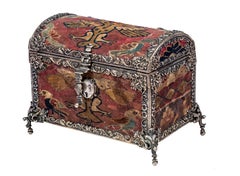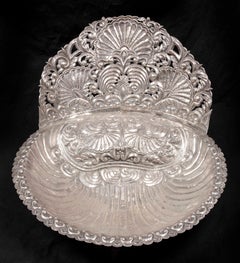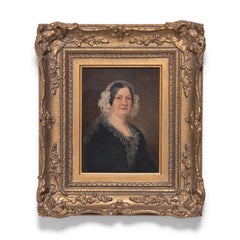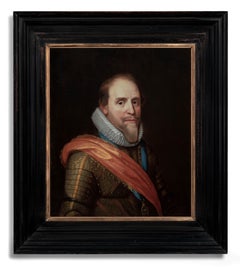Spanish Colonial (Peruvian) Art
to
2
2
2
1
Silver and Transitional Andean Textile Casket
By Spanish Colonial (Peruvian)
Located in New York, NY
Silver was the material of choice for both ecclesiastical and domestic vessels in the New World, not only for its status as a precious metal, but also because of its abundance and du...
Category
Early 18th Century Spanish Colonial (Peruvian) Art
Materials
Silver
Cuzco School Baptismal Dish
By Spanish Colonial (Peruvian)
Located in New York, NY
Provenance:
Manuel Ortíz de Zevallos y García, Peru; and by descent in the family to:
Private Collection, New York.
This impressive baptismal dish is an example of eighteenth-cent...
Category
18th Century Old Masters Spanish Colonial (Peruvian) Art
Materials
Silver
Related Items
Oil Portrait of a Victorian Lady, c. 1850
Located in Chicago, IL
Painted in the 19th century, this exquisite miniature portrait wonderfully exemplifies realism in traditional oil painting. The small artwork is painted in the conventional portraiture style of the Old Masters, and achieves soft realism with fine brushwork and a subdued, neutral palette. The half length portrait depicts a fine Victorian woman dressed in all black with a delicate lace collar and bonnet. She wears a ruby broach...
Category
Mid-19th Century Old Masters Spanish Colonial (Peruvian) Art
Materials
Oil
Dutch Old Master Portrait of Maurits, Prince of Orange-Nassau, Oil on Panel
Located in London, GB
In 1607, the Delft city council decided to commission a portrait of Stadholder Maurits of Nassau for the town hall, with Michiel van Mierevelt as the chosen artist due to the passing...
Category
17th Century Old Masters Spanish Colonial (Peruvian) Art
Materials
Oil, Wood Panel
$11,674
H 37.8 in W 33.47 in D 2.37 in
The Necklace of Jane Seymour, Henry VIII's Third Wife, Limited Edition, Signed
By Hiroshi Sugimoto
Located in New York, NY
Hiroshi Sugimoto
The Necklace of Jane Seymour, Henry VIII's Third Wife, 2000
Limited Edition Signed pendant of silver-plated brass, imitation pearls, Swarovski glass stones, handmade...
Category
16th Century Old Masters Spanish Colonial (Peruvian) Art
Materials
Metal
Portrait of Lady, Barbara Herbert, Countess of Pembroke c.1708, Large Painting
Located in London, GB
Portrait of Barbara Herbert, Countess of Pembroke c.1708
Charles d’Agar (1669-1723)
This magnificent large-scale portrait, presented by Titan Fine Art, depicts the British court of...
Category
17th Century Old Masters Spanish Colonial (Peruvian) Art
Materials
Cotton Canvas, Oil
$17,342
H 49.61 in W 46.86 in D 2.76 in
Portrait of a Lady, Mrs Wray in a Silk Dress & Pink Wrap c.1698, Oil on canvas
By Michael Dahl
Located in London, GB
Portrait of a Lady, Mrs Wray in a Silk Dress & Pink Wrap c.1698
Circle of Michael Dahl (1659-1743)
This delightful work, presented by Titan Fine Art, is a fine example of British po...
Category
17th Century Old Masters Spanish Colonial (Peruvian) Art
Materials
Cotton Canvas, Oil
$14,103
H 34.65 in W 29.93 in D 2.37 in
Portrait of lady, Mary Hammond in Rich Attire, Jewels, Lace c.1618-22 Historical
By Cornelius Johnson
Located in London, GB
Portrait of Mary Hammond in Sumptuous Attire, Jewels and Lace c.1618-22
Circle of Cornelius Johnson (1593-1661)
This portrait of a lady, presented by Titan Fine Art, is an exquisite...
Category
17th Century Old Masters Spanish Colonial (Peruvian) Art
Materials
Oil, Panel
$19,367
H 33.47 in W 27.17 in D 2.37 in
Seventeenth Century Old Master Biblical Oil Painting Joseph recounts his Dream
By Rembrandt van Rijn
Located in ludlow, GB
Seventeenth Century Old Master Biblical themed Oil Painting on Panel of Joseph recounting his Dream. A Follower of Rembrandt Harmensz Van Rijn 1606 - 1669. This painting follows a ...
Category
17th Century Old Masters Spanish Colonial (Peruvian) Art
Materials
Oil
$16,195
H 22 in W 19 in D 1 in
Portrait of a Gentleman, David Erskine, 13th Laird of Dun, Wearing Armour c.1700
Located in London, GB
The gentleman in this exquisite oil on canvas portrait, presented by Titan Fine Art, is shown with the grandiloquence characteristic of the English School of painting. He is portray...
Category
17th Century Old Masters Spanish Colonial (Peruvian) Art
Materials
Oil, Canvas
$8,030
H 35.44 in W 30.71 in D 2.37 in
Portrait Gentleman Armour, Blue Cloak, Diamond Brooch c.1700 French Carved Frame
By Joseph Vivien
Located in London, GB
Portrait of a Gentleman in Armour and Azure Cloak with Diamond Brooch c.1700
Attributed to Joseph Vivienne (1657-1735)
The sitter in this superb portrait, offered by Titan Fine Art...
Category
17th Century Old Masters Spanish Colonial (Peruvian) Art
Materials
Oil, Cotton Canvas
$18,152
H 35.83 in W 29.93 in D 3.15 in
Portrait of Gentleman in blue, Portrait of Lady, oval pair Fine Carved Frames
Located in London, GB
Portrait of a Gentleman with Blue Cloak and Portrait of a Lady in Russet Dress c.1697
Thomas Murray (1663-1735)
These fascinating portraits are exquisite examples of portraiture in ...
Category
17th Century Old Masters Spanish Colonial (Peruvian) Art
Materials
Oil, Canvas
$26,250
H 37.8 in W 33.47 in D 2.76 in
Gold Laugh, Post-Modern Metallic Woven Abstract Textile Sculpture/Embroidery
By Micheline Beauchemin
Located in Wilton, CT
Gold Laugh (1980-85) metallic and acrylic thread, cotton. Gold, Metallic Woven Abstract Textile Sculpture.
Textile artist, Micheline Beauchemin (1929-2009) was born in Longqueuil, Quebec, Canada. She has created a repertory of various works which includes theatre curtains, tapestries, wall hangings, embroidery murals, flexible walls, stained glass works, scale models, collages, toys, costumes and illustrations. Micheline Beauchemin began her career making stained-glass windows but early on turned to weaving and embroidering spectacular wall hangings in vibrant colors, including blues and greens. travelled and studied in Japan, China, India, North Africa, the Canadian Arctic and the Andes, adding depth and mystery to the love of light, water, wings and nets that is evident in her body of work.
Beauchemin’s works are included in the collections of the National Gallery of Canada, Ottawa; the Montreal Museum of Fine Arts; the Musée du Québec; Pearson Airport, Toronto; the Canada Council, Ottawa; the Canadian Museum of Civilization, Gatineau; the Bibliothèque Centrale, Quebec; the Taxation Data Centre, Shawinigan; the Revenue Building, Québec; North York...
Category
1980s Post-Modern Spanish Colonial (Peruvian) Art
Materials
Metal
$3,800
H 25.25 in W 21.25 in D 2.25 in
WATER RIFLE - Modern obiect sculpture made of steel and fabric
By Sylwia Jakubowska-Szycik
Located in Salzburg, AT
Sylwia Jakubowska-Szycik is professor at the Academy of Fine Arts at the Faculty of Sculpture and Intermedia in Gdańsk, she conducts classes in the f...
Category
2010s Contemporary Spanish Colonial (Peruvian) Art
Materials
Stainless Steel
$2,018
H 33.08 in W 9.06 in D 1.58 in
Spanish Colonial (peruvian) art for sale on 1stDibs.
Find a wide variety of authentic Spanish Colonial (Peruvian) art available for sale on 1stDibs. You can also browse by medium to find art by Spanish Colonial (Peruvian) in metal, oil paint, paint and more. Much of the original work by this artist or collective was created during the 18th century and earlier and is mostly associated with the Old Masters style. Not every interior allows for large Spanish Colonial (Peruvian) art, so small editions measuring 17 inches across are available. Customers who are interested in this artist might also find the work of Studio of Sir Peter Lely, Sir Godfrey Kneller, Flemish School, and 17th Century. Spanish Colonial (Peruvian) art prices can differ depending upon medium, time period and other attributes. On 1stDibs, the price for these items starts at $3,075 and tops out at $25,000, while the average work can sell for $23,000.



